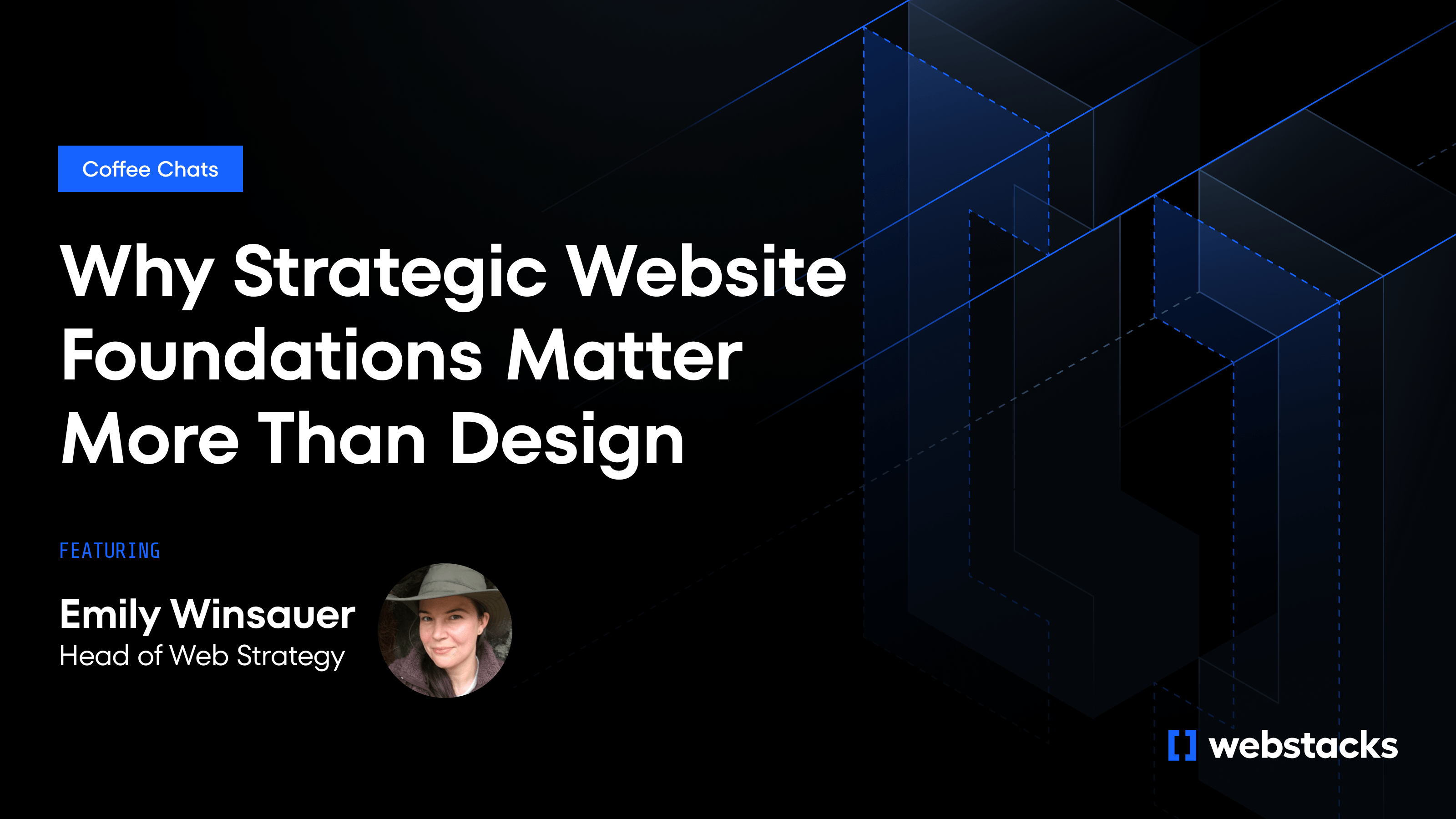Enterprise website initiatives shouldn't require diplomatic negotiations between conflicting departments. Marketing teams demand conversion optimization, developers manage composable architecture complexity and analytics teams drown in disconnected data streams. AI-driven kickoff prompts align every stakeholder from day one and establish automated KPI tracking before the first development ticket gets assigned. They eliminate the disconnected spreadsheets that typically follow project kickoffs.
This guide addresses marketing leaders who need technical alignment without managing developer workflows daily. You'll learn prompt frameworks that lock in business objectives, minimal infrastructure requirements to get started and templates you can deploy immediately.
The Alignment Problem: Why Traditional Kickoffs Fail
Traditional kickoffs fail because they ask humans to manually synchronize information that exists in different systems, spoken in different vocabularies and optimized for different outcomes. Three structural disconnects make this synchronization nearly impossible regardless of how many alignment meetings you schedule.
Every web team knows the pattern: marketing schedules a kickoff meeting to launch a new campaign, development shows up with questions about technical feasibility and analytics raises concerns about measurement gaps. Two hours later, the team leaves with action items but no shared understanding of success. The campaign launches late, metrics conflict across departments and the post-mortem reveals the same coordination failures that plagued the last three initiatives:
- Siloed analytics tools create fractured visibility. Marketing stares at GA4, engineering pulls Looker dashboards and ops monitors performance tools. Without shared context, teams debate data integrity instead of fixing conversion leaks. Separate reporting stacks amplify this fragmentation.
- Performance ownership remains ambiguous. When no one owns the "demo-request" metric, it drifts. Calendly experienced this before its Webstacks rebuild. Shipping new landing pages required engineering tickets and approval loops. After establishing clear performance stewards, the company cut release cycles and achieved 10× faster time-to-market.
- Marketing velocity and developer stability priorities collide. After unifying these competing objectives, Circle generated a 500% spike in product-demo requests through its website redesign.
This is where AI-powered kickoff frameworks redefine alignment. Traditional dashboards overflow with vanity metrics. Teams must sift through hundreds of possible measurement points without context. Campaign adjustments arrive weeks after underperformance begins.
AI-powered kickoffs establish shared KPIs, automated data collection and role-based ownership in a single coordinated prompt. When business objectives, data definitions and team responsibilities get hard-wired into that opening conversation, every sprint anchors to metrics that matter.
What AI-Powered Kickoffs Need to Work
You need two foundational elements: performance data your AI can interpret and an accessible platform where you can design prompts. If you can export a CSV from GA4 and access ChatGPT or Claude, you have enough to start.
The barrier isn't sophisticated AI infrastructure or expensive tools. Teams already possess the core elements needed for AI-powered kickoffs but haven't connected them in ways that enable effective coordination. The sophistication comes from how you structure your data and prompts, not the underlying technology.
Connecting Metrics to Events
Agreeing on which metrics actually matter is the real challenge, not the technical work of tracking them. Every performance indicator needs a direct path to measurable events before your AI can surface actionable insights.
- Select business-critical indicators. B2B SaaS teams typically track sales-qualified leads, demo requests and pipeline influence. These metrics appear in executive dashboards and build credibility with leadership. Choose indicators your team already monitors consistently rather than introducing new measurement frameworks during kickoff implementation.
- Identify leading indicators. SQLs emerge from earlier signals: CTA clicks, 50% page scrolls and form starts. Map which leading indicators correlate most strongly with your lagging metrics. If 50% scroll depth predicts demo requests better than CTA clicks in your data, weight your prompt accordingly.
- Tag CMS components. Tag at the component level, not the page level. In Next.js sites running Contentful, embed a data-kpi attribute on every component that influences target metrics: <Button data-kpi="demo_request">. When your hero component appears on five pages, one tag update propagates everywhere.
- Build clean data connections. The AI needs timestamped business events with clear attribution: "User clicked demo CTA on /pricing page at 2:34 PM, converted to SQL 6 hours later." Route instrumented events through your analytics platform into a format your LLM can access: CSV exports, API connections or data warehouse queries.
Event-level data enables pattern recognition. Aggregated metrics without user-level granularity produce generic recommendations.
Your first kickoff should use metrics you're already tracking reliably, even if they're not perfect. Score each indicator on revenue impact and instrumentation difficulty. A well-instrumented proxy metric beats a poorly-tracked ideal metric.
Choosing Your AI Platform
Start with the platform your organization already uses for AI experimentation. For kickoff coordination, the specific platform matters less than having structured access to your team's performance data.
Hosted LLM platforms like ChatGPT Enterprise, Claude or Gemini are the typical starting point. These platforms provide immediate access without requiring GPU provisioning, containerization or ongoing DevOps support. They offer contractual data privacy guarantees, connect to your data through API integrations and deploy in hours rather than weeks.
Self-hosted options like Llama provide complete data isolation behind your firewall and enable full fine-tuning. These require up-front hardware investment and ongoing operational overhead. Consider self-hosted deployment only when data sovereignty requirements are non-negotiable. With data connected and platform selected, your prompt design determines whether AI generates generic recommendations or game-changing sprint plans.
Prompt Design Framework: Engineering High-Impact Kickoffs
Generic context produces generic recommendations. Precise constraints enable the AI to reason about your actual business environment.
Kickoff prompts establish the contract aligning marketing, design and development on measurable success criteria rather than just project deliverables. When you provide comprehensive context and explicit formatting requirements, AI returns actionable sprint plans integrating directly with existing workflows.
Core Prompt Principles
Constraint specification determines prompt quality. Successful prompts mirror strategic discussions happening in actual planning meetings. Context should include brand voice guidelines, target buyer personas, CMS technical constraints, sprint cadence and current baseline metrics. Role declaration immediately frames the AI's perspective. "You are the Web Team's strategic co-pilot" produces fundamentally different outputs than generic task assignment.
Weak prompts say "CMS: Contentful." Strong prompts say "CMS: Contentful with 47 existing content types, 200-page migration completed Q2 2024, webhook rate limit of 60 requests/minute, currently managing 15 active campaigns." Additional context prevents the AI from recommending solutions your infrastructure can't support. Specify output structure that matches your project management workflow exactly. Output formatting requirements are non-negotiable.
If your team uses Jira with specific custom fields (Story Points, Sprint Goal Alignment, Technical Dependency Tags), instruct the AI to generate output including those fields. Section delimiters like <<CONTEXT>> and <<OUTPUT>> prevent instruction bleed. The model maintains distinct focus throughout complex briefs.
Include iteration loops by ending prompts with "Ask clarifying questions before answering if information is missing." This prevents hallucinated assumptions that derail implementation when AI fills gaps with plausible-sounding but incorrect technical details. For complex integration scenarios like connecting Contentful webhooks to data warehouses, this invokes systematic reasoning mirroring your technical team's problem-solving methodology.
Essential Prompt Components
Each of five components prevents a specific type of kickoff failure. Skip any one and you'll see that failure pattern emerge in your sprint outcomes.
The difference between prompts that generate usable backlogs and prompts that produce high-impact sprint plans lies in how thoroughly you address these five coordination failure points. High-performing teams specify the revenue math, technical boundaries, team capacity constraints and measurement rigor that turn AI recommendations from theoretically sound to operationally executable.
Business context: Include why this target matters to help the AI prioritize tasks that directly influence the constraint. Specific revenue impact and pipeline contribution requirements work better than vague goals.
"Increase demo requests by 20% QoQ" beats "improve conversion." Example: "20% QoQ growth maintains our current CAC:LTV ratio as we scale from $10M to $15M ARR."
Technical requirements: Specify what you can't change more explicitly than what you can. Stack specifications (Next.js + Contentful), repository structure and API limitations constrain solutions.
Example: "Cannot modify authentication system (enterprise SSO contract locked until Q4 2025), cannot add external JavaScript libraries without security review (4-week approval cycle), must maintain sub-2-second page load on mobile."
Target metrics: Include baseline, target and the underlying conversion math to prevent the AI from suggesting traffic acquisition tactics when you need conversion optimization. Measurable outcomes the AI tracks and optimizes for: SQL generation rates, Core Web Vitals benchmarks, indicators influencing CFO dashboards.
Example: "Current: 150 demos/month from 45,000 monthly visitors (0.33% conversion). Target: 180 demos/month. Constraint: Traffic growth limited to 5% QoQ, so must achieve target through conversion rate improvement to 0.37%."
Role assignments: Granular capacity mapping enables the AI to generate realistic task assignments accounting for actual team bandwidth and skill levels. Clear ownership distribution across marketing, design and engineering functions prevents responsibility gaps.
Example: "Marketing PM: 20 hours/sprint, experienced with Contentful but limited HTML/CSS knowledge. Front-end dev: 30 hours/sprint after accounting for maintenance work, expert in React but new to our design system."
Success criteria: Detailed specification ensures the AI understands you need actual statistical validation, not just directional improvement. Include measurement methodology for how you'll measure whether the sprint achieved its goals: percentage lifts, absolute numbers or time-to-completion thresholds.
Example: "Success: 20% lift in demo requests measured via GA4 conversion tracking, statistically significant at p<0.05 using two-sample t-test comparing 2-week pre-launch vs. 2-week post-launch periods."
Production-Ready Kickoff Template
Copy this template, replace placeholder values with your actual team data and run your first AI-coordinated kickoff today. The template below represents the distilled structure from dozens of successful AI-powered kickoffs across B2B SaaS companies.
It balances comprehensiveness with practicality: detailed enough that the AI generates actionable recommendations, concise enough that you can customize it in under 30 minutes. Teams typically see immediate value in sprint 1, then refine the template based on what the AI got right and where it missed the mark.
<<ROLE>>
You are the Web Team's strategic co-pilot facilitating a two-week sprint kickoff.
<<CONTEXT>>
Brand voice: analytical, confident, avoids marketing jargon
CMS: Next.js 14 + Contentful (47 content types, webhook rate limit: 60/min)
Objective: Increase demo requests by 20% QoQ (150 to 180/month)
Current baseline: 150 demos/month from 45,000 visitors (0.33% conversion)
Constraint: Traffic growth limited to 5%, must achieve via conversion rate lift to 0.37%
Team capacity:
- Marketing PM: 20 hrs/sprint, Contentful expert, limited HTML/CSS
- UX designer: 15 hrs/sprint, new to product, needs PM spec review
- Front-end dev: 30 hrs/sprint after maintenance, React expert
<<EXISTING_DATA>>
Recent GA4 insights:
- Pricing page visitors convert at 2.1× site average
- Users who scroll past comparison table convert at 3.2× rate
- Mobile form abandonment: 67% (desktop: 34%)
<<TECHNICAL_CONSTRAINTS>>
- Cannot modify auth system (locked until Q4 2025)
- No external JS libraries without 4-week security review
- Must maintain sub-2-second mobile page load
<<TASKS>>
Generate a prioritized sprint backlog addressing:
1. High-impact conversion optimizations based on GA4 data
2. Mobile form experience improvements
3. Component-level changes that don't require new content types
For each task, specify:
- Owner (matching team capacity constraints)
- Estimated hours
- Dependencies
- Success metric
- Risk level (High/Medium/Low based on technical complexity)
<<OUTPUT>>
Return as Markdown table with columns:
Task | Owner | Hours | Dependencies | Success Metric | Risk
Include 2-3 sentence sprint goal summarizing the conversion strategy.
<<ITERATION>>
Ask clarifying questions if critical context is missing before generating the board.
This template provides the AI with actual performance data it can act on (scroll behavior, device-specific conversion rates). It produces recommendations grounded in constraints, team capacity, and risk awareness rather than generic task lists.
The sprint goal requirement forces the AI to synthesize individual tasks into a coherent strategy. When the model must explain strategy, it produces more strategically aligned backlogs.
Customize this template with actual project data rather than generic placeholders. The more specific your context, the more actionable your output.
Specialized Kickoff Variations
Different coordination challenges require adapted prompts. Maintain consistent structure (role declaration, comprehensive context, explicit tasks, output formatting and iteration loops) while addressing specific alignment needs. These variations show which context elements matter most for each scenario type.
Marketing + Dev Alignment Kickoff: Add explicit deadline constraints and campaign calendar context when marketing has campaign deadlines developers aren't aware of.
Add to <<CONTEXT>>: "Upcoming campaign: Product launch webinar on March 15 requires updated /product page and new /webinar-registration landing page. Hard deadline: March 12 for QA. Marketing has committed to external vendors and cannot move date."
Design System Integration Kickoff: Add component inventory and design token specifications when migrating to a new design system or expanding an existing one.
Add to <<CONTEXT>>: "Existing design system: 23 React components in Storybook, Tailwind-based, 8 color tokens, 4 spacing scales. Figma source of truth: 47 component variants, 12 not yet built in React. Priority: implement high-use components first based on page frequency analysis."
CMS Content Architecture Kickoff: Add existing content audit data and editor workflow constraints when restructuring content models or planning migrations.
Add to <<CONTEXT>>: "Current Contentful setup: 47 content types, 1,200 published entries, 8 content editors with varying skill levels (3 advanced, 5 basic). Pain point: editors confused by 14 similar-but-different 'Page' content types. Goal: consolidate to 5 primary content types without breaking 200+ published pages."
Data-Driven Sprint Planning Kickoff: Attach actual analytics exports rather than summary statistics when you have rich performance data.
Prompt the AI: "Analyze attached ga4_export.csv. Identify the top 3 conversion optimization opportunities based on: (1) page traffic volume, (2) current conversion rate, (3) engagement signals suggesting intent. Prioritize pages where small conversion rate improvements yield significant absolute demo increases."
Common Kickoff Prompt Failures and Fixes
Your first AI-generated kickoff will likely contain at least one recommendation that makes your developers or marketing team immediately say "we can't do that." The four failure patterns below represent 80% of the issues teams encounter in their first three AI-powered kickoffs.
Recognizing these patterns quickly means you can fix your prompt and re-run the kickoff in minutes rather than discovering the problem mid-sprint when a developer flags an impossible task. Each failure pattern below includes the symptom you'll see in the AI output, the root cause in your prompt structure and the specific fix to add.
Teams typically eliminate these failures entirely by sprint 4 or 5 as their prompts accumulate the necessary constraint detail.
Failure: AI recommends technically infeasible solutions
Symptom: Sprint backlog includes "Implement real-time personalization engine" when your CMS doesn't support dynamic content rendering.
Fix: Expand <<TECHNICAL_CONSTRAINTS>> with explicit capability limitations: "CMS: Contentful serves static content only, no edge computing, no server-side rendering. Personalization must use client-side JavaScript with data from existing API endpoints."
Failure: Generic, non-actionable tasks
Symptom: AI generates "Improve site performance" or "Enhance UX" without specifics.
Fix: Add to <<OUTPUT>>: "Every task must include: (1) specific component or page being modified, (2) measurable acceptance criteria, (3) the metric it's intended to improve and by how much. Reject vague improvements."
Failure: Unrealistic task time estimates
Symptom: AI assigns 2-hour estimates to tasks your team knows require 8 hours.
Fix: Add <<VELOCITY_CALIBRATION>> section: "Historical task completion data: Component redesigns average 12 hours (range: 8-16). New page builds average 20 hours (range: 15-28). A/B test implementation average 6 hours (range: 4-10). Use these ranges for estimation."
Failure: Task dependencies not identified
Symptom: Sprint backlog has front-end work scheduled before design specs exist.
Fix: Add to <<CONTEXT>>: "Standard workflow: (1) UX designer creates Figma spec → (2) Marketing PM reviews and approves → (3) Front-end dev implements → (4) QA testing → (5) Deployment. Tasks must respect this sequence. Flag any task requiring out-of-sequence work."
When recommendations seem off, the fix usually involves adding constraints or historical data. Kickoff prompt failures typically stem from the AI lacking context you have but forgot to specify.
Iterating Your Kickoff Prompts
Feed performance results back into the model after each sprint to improve predictions for the next kickoff. Your kickoff prompt becomes more valuable when you refine it based on what actually happened during the sprint.
Refinement Based on Sprint Outcomes
Include not just the outcome but the underlying behavioral data explaining it. Update your prompt's baseline metrics with actual results.
If your sprint targeted 20% demo request growth but achieved only 12%, feed that gap back into the next kickoff prompt along with hypotheses about what limited performance.
Example evolution:
Sprint 1 prompt:
Current baseline: 150 demos/month from 45,000 visitors (0.33% conversion)
Target: 180 demos/month (20% increase)Sprint 1 outcome: Achieved 168 demos (12% increase, missed target)
Sprint 2 prompt (refined):
Current baseline: 168 demos/month from 46,000 visitors (0.365% conversion)
Target: 180 demos/month (7% increase to hit original QoQ goal)
Sprint 1 learning: Implemented hero CTA redesign and mobile form optimization.
Mobile conversion improved 28% (0.21% to 0.27%) but desktop conversion
decreased 8% (0.51% to 0.47%), likely due to new hero layout reducing
trust signals above fold. Net: missed target.
Sprint 2 constraint: Maintain mobile conversion gains while recovering
desktop trust signals. Prioritize above-fold trust elements
(customer logos, security badges) over visual redesign.The evolved prompt captures the causal insight and translates it into actionable constraints for the next sprint. The AI now understands that the team is optimizing for a specific conversion challenge rather than generic "increase conversions."
Specify not just the limit but the symptom that revealed it when adding discovered constraints to your technical requirements section. When a sprint reveals that your CMS webhook has rate limits preventing real-time updates, that constraint belongs in every subsequent kickoff prompt.
Example: "Webhook rate limit: 60 requests/minute. Discovered when campaign launch with 200 simultaneous page publishes failed. Workaround: batch publish operations with 2-minute delays between batches."
Include the reason for the shift when refining role assignments based on actual ownership patterns. If your marketing PM consistently handled tasks assigned to the UX designer, update the prompt to reflect real team capacity.
Example: "UX designer: Originally allocated 15 hrs/sprint but consistently delivers 8-10 hrs due to Product team commitments. Marketing PM has absorbed component specification work (4-5 hrs/sprint) and now requires design system familiarity in task assignments."
Building a Prompt Library
Prompt libraries transform one-off coordination wins into repeatable processes, ensuring your team's best practices compound rather than getting lost in Slack threads. Create a base template with your team's standard context, then maintain specialized extensions for different initiative types. Store prompts in a shared repository where team members can access proven templates for common coordination challenges: design system integration, CMS migrations, performance optimization sprints.
When starting a design system integration kickoff, you load the base template plus the design-system-specific context additions.
When a particular kickoff template consistently generates well-prioritized sprint backlogs, promote it to your standard template and retire less effective variations. Version control lets you trace which prompt variations produced the best alignment outcomes.
Track not just whether the AI generated a usable backlog, but whether the sprint hit its success criteria. A prompt that produces elegant task lists but misses target metrics is less valuable than a prompt generating output that accurately predicts high-impact work.
From Coordination Tax to Competitive Advantage
By establishing shared KPIs, automated task generation and role-based ownership in your initial prompt, you eliminate the negotiation cycles typically delaying enterprise projects. AI-powered kickoffs transform the coordination bottleneck at the start of every sprint into a streamlined alignment process.
The prompts you design become more effective with each sprint as you feed actual performance data back into the model. The KPI mapping framework you established ensures every kickoff anchors to metrics that matter. The five-component prompt structure provides consistent scaffolding that captures learnings systematically. The iteration loops surface gaps and edge cases that get hardened into your base templates.
Your prompt library preserves these refinements, making institutional knowledge accessible to every team member. Your tenth AI-powered kickoff will be dramatically more precise than your first because each cycle compounds clarity around business objectives, team constraints and technical requirements.
When your prompt captures hard-won lessons about what works in your specific technical environment, with your specific team capacity and targeting your specific user behaviors, it becomes a strategic asset that accelerates every subsequent sprint. AI-powered kickoffs create value by codifying institutional knowledge that would otherwise live only in senior team members' heads.
Componentized Next.js architecture layered on headless CMS provides the foundation for rapid iteration. AI-powered kickoffs ensure every sprint begins with clarity about what to build, who owns each piece and which metrics define success.
Ready to eliminate coordination delays in your next sprint? Schedule a chat with Webstacks to implement AI-driven kickoff frameworks tailored to your tech stack, team structure and growth metrics. You'll run your first AI-coordinated kickoff within two weeks and begin building the prompt library that turns every future sprint into a more precise, data-informed planning session.




